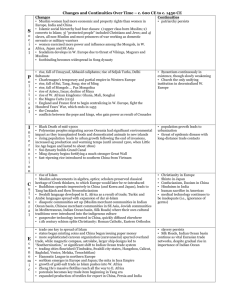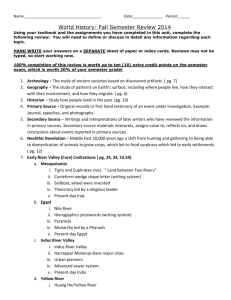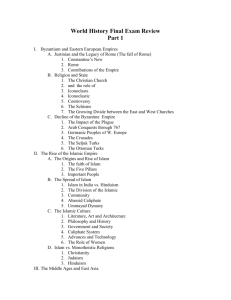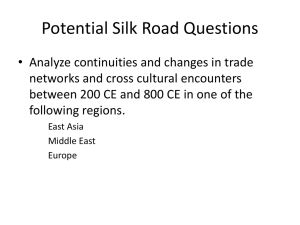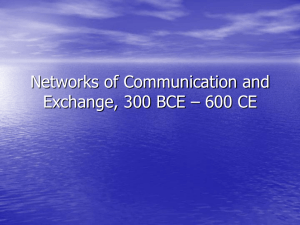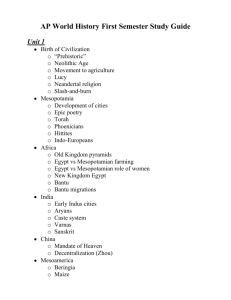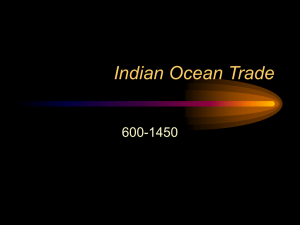Analyze the cultural and political changes and continuities in
advertisement
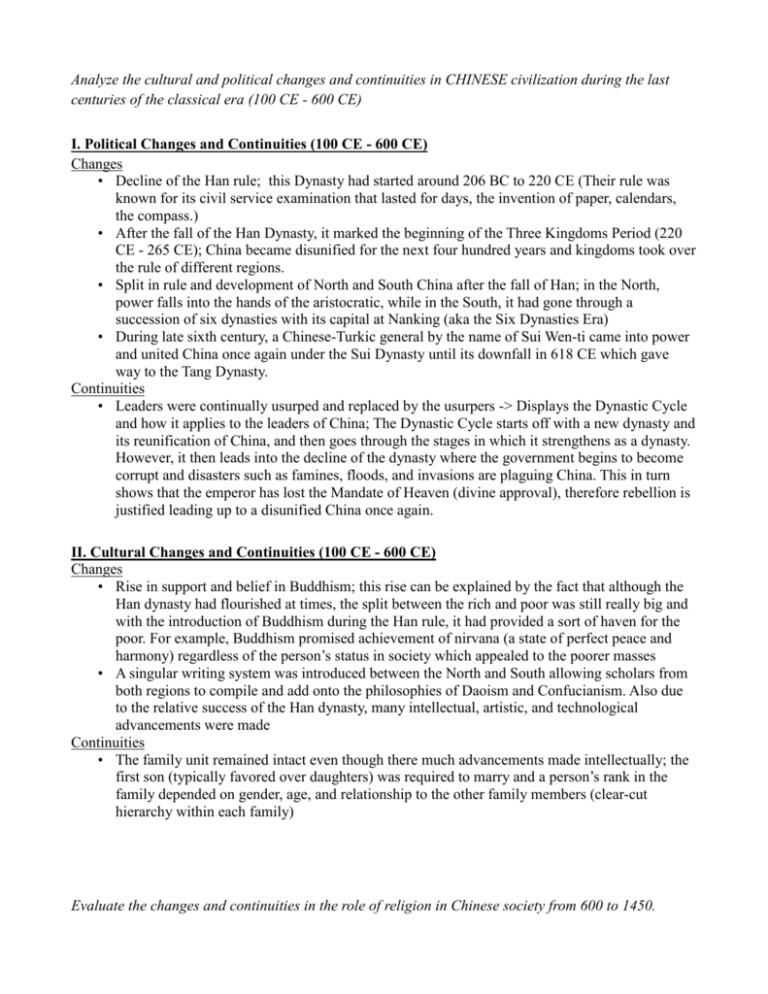
Analyze the cultural and political changes and continuities in CHINESE civilization during the last centuries of the classical era (100 CE - 600 CE) I. Political Changes and Continuities (100 CE - 600 CE) Changes • Decline of the Han rule; this Dynasty had started around 206 BC to 220 CE (Their rule was known for its civil service examination that lasted for days, the invention of paper, calendars, the compass.) • After the fall of the Han Dynasty, it marked the beginning of the Three Kingdoms Period (220 CE - 265 CE); China became disunified for the next four hundred years and kingdoms took over the rule of different regions. • Split in rule and development of North and South China after the fall of Han; in the North, power falls into the hands of the aristocratic, while in the South, it had gone through a succession of six dynasties with its capital at Nanking (aka the Six Dynasties Era) • During late sixth century, a Chinese-Turkic general by the name of Sui Wen-ti came into power and united China once again under the Sui Dynasty until its downfall in 618 CE which gave way to the Tang Dynasty. Continuities • Leaders were continually usurped and replaced by the usurpers -> Displays the Dynastic Cycle and how it applies to the leaders of China; The Dynastic Cycle starts off with a new dynasty and its reunification of China, and then goes through the stages in which it strengthens as a dynasty. However, it then leads into the decline of the dynasty where the government begins to become corrupt and disasters such as famines, floods, and invasions are plaguing China. This in turn shows that the emperor has lost the Mandate of Heaven (divine approval), therefore rebellion is justified leading up to a disunified China once again. II. Cultural Changes and Continuities (100 CE - 600 CE) Changes • Rise in support and belief in Buddhism; this rise can be explained by the fact that although the Han dynasty had flourished at times, the split between the rich and poor was still really big and with the introduction of Buddhism during the Han rule, it had provided a sort of haven for the poor. For example, Buddhism promised achievement of nirvana (a state of perfect peace and harmony) regardless of the person’s status in society which appealed to the poorer masses • A singular writing system was introduced between the North and South allowing scholars from both regions to compile and add onto the philosophies of Daoism and Confucianism. Also due to the relative success of the Han dynasty, many intellectual, artistic, and technological advancements were made Continuities • The family unit remained intact even though there much advancements made intellectually; the first son (typically favored over daughters) was required to marry and a person’s rank in the family depended on gender, age, and relationship to the other family members (clear-cut hierarchy within each family) Evaluate the changes and continuities in the role of religion in Chinese society from 600 to 1450. I. Changes in the Role of Religion in Chinese Society (600 - 1450) • Religion began taking on more secular responsibilities such as having their temples serve as schools, inns, and bath houses. Some were even able to lend money, disperse medicines to the public, as well as monopolize revenues. This was due to the increase of support of Buddhism by the Tang Dynasty’s emperors, and aristocrats and it’s popularity among the more powerful people of Chinese society • It became a carrier of new traditions and styles during the Tang Dynasty because along with the Buddhist pilgrims that flooded in from India, also came the foreign culture of India which spread among the elite. • Buddhism became a justification for women to join in the world of politics. This was due to the female emperor Wu Zhao that Buddhism was viewed this way because she had declared her legitimacy as emperor by calling herself an enlightened soul that was sent to earth to lead others to salvation. II. Continuities in the Role of Religion in Chinese Society (600 - 1450) • There is a continual pattern between the times when Buddhism is more favored among the people therefore playing a larger role and the times when Confucianism became the more favored philosophy therefore diminishing the role that Buddhism had. When one appealed to the masses more, the other one was typically not as favorable. For example, the Tang Dynasty was known to be the golden age of Buddhism meaning that the Confucian philosophy wasn’t as favored among the people. One of the characteristics of the Tang Dynasty was that it was more cosmopolitan than the other dynasties which meant that they were more open to outside influences, which included Buddhism - Confucianism was more popular later during the Song Dynasty because one of the characteristics of this dynasty would be that it focused more on education and higher literacy which is what the philosophy stresses in general Interregional Trade in Asia from 600 C.E. to 1450 C.E. Analyze and describe the impact of interregional trade on ASIA during the period 600 to 1450. Be sure to discuss continuities as well as the changes that resulted from the trade networks. • Many trade routes operating. The two major ones: Silk Road and Indian Ocean Network 1. Indian Ocean Trade Network • Indian Ocean trade allowed cultures to mix, Africans able to trade with Chinese using other Asians as intermediaries • allowed Indian and East African cultures to mix • brought Islam to the coastal Bantu speakers and led to the creation of Swahili • Indian Ocean Trade Network 2. Silk Road • Silk Road heavily used as well, allowed Chinese goods to go into Europe for the first time ever • heavily used during the Mongol period, spread Buddhism and Christianity and led to the creation of better roads and boats • also made Europeans interested in finding a water route to China • new monetary systems developed 3. Asians and Europeans never came into direct contact with each other 4. used Africans as intermediaries 5. more access to goods by many different peoples 6. both cultures received items never thought possible before Analyze major changes and continuities in the formation of national identities in EAST ASIA from 1900 to the present. 1900-WWII China is not united, most of the country is the poor working class, and the upper class takes most of the harvest. Foreigners in treaty ports are living in luxury, and negatively impact the view of the West. Chinese politics at the time is clinging to tradition. 1900- Empress Dowager CiXi tries to expel all the foreigners from China after seizing power. Western Powers and Japan force China to pay indemnity after capturing Beijing. This is when students decide China needs to be modernized. Japan is quickly modernizing, but makes a distinction between Western culture and its own. 1915-Japan forces China to turn into a virtual protectorate with its Twenty-One Demands, this sparks nationalism and student protests. The Great Depression made super nationalists in Japan seek out a colony in China. During the Sino Japanese War (1937-1945), Mao and his army were the only group that put serious effort into fighting the Japanese and gained support from peasants. WWII-Present Japan is put into a losing position after the Battle of Midway, and can no longer try to colonize East Asia. The Guo Ming Dong gets US aid and encouragement to unite, but prepares for civil war with the Communists under Mao instead. Mao Ze Dong takes over and founds the People’s Republic of China. 1970s Other Asian states imitate Japan’s method of industrialization. The idea of working for the welfare of the nation is prevalent. China institutes economic reforms after Mao Ze Dong dies and economic reforms are instituted, but state control of economy remains the same. Political Sphere is still chaotic in China (Tianamen Square) due to the lack of political freedom. Students and intellectuals united to challenge the government in favor a democracy. Analyze major changes and continuities in the formation of national identities in SOUTHEAST ASIA from 1900 to the present. Be sure to include evidence from specific countries in the region selected. I. The Beginning: • Europeans first began to colonize Southeast Asia in the sixteenth century with the interest for trade. • Buddhism had been in these areas for centuries, and would remain a strong unifying, anti-western force. • The Europeans brought new ideas and ideologies, along with technology to the Southeast Asian countries. Some of the new ideas promoted equality and democracy. II. World War Two: • World War Two was instigated by nationalism. • The colonies felt they should also start to fight for their own independence and nationalist feelings rose up. • European countries were focused more on domestic problems, rather than the tensions and uprisings in their Asian colonies. III. Japan and World War Two: • During the second world war, Japan occupied Southeast Asian colonies. • Southeast Asians realized that Europe was not as invincible as it had seen before, as it lost control of its colonies to Japan. a. Indonesia a. -nationalist leaders were released from jail by the Japanese and allowed to hold mass rallies. b. Vietnam: a. When the French lost power in Vietnam, the Japanese sent officials to administer the area, but too few, resulting in a power vacuum. Nationalists saw their chance, and began to take immediate action. c. Indonesia: a. Japan’s failure to fulfill its vague promises of Indonesian independence pushed nationalist leaders to decide to take the matters onto their own hands. ← IV. Communism: • Malaya, Singapore, Sabah, and Sarawak: gained independence once the British were able to suppress the rise of communism in the Malayan Emergency from 1945 to 1960. • Communist North Vietnam was able to achieve independence with support from Communist China. Patterns of Interactions Along the Silk Roads from 200 BCE to 1450 CE Silk Road Network of trade routes connecting Europe and Asia Two main routes: Connected Eastern Mediterranean to Central Asia Connected Central Asia to China First used during the Han Dynasty (~200 BCE) when China gained access to western territories Passes through Taklimakan Desert (little rain and vegetation) Merchants attacked by Central Asian tribes; India became the middleman to “secure” the goods halfway through the process Commodities China: silk, porcelain, spices, precious woods Silk: woven into clothing denoting wealth, attracted upper class Silk spinning method was kept secret for hundreds of years, makes Europeans want to continue trade Europe: wool cloth, gold, silver India (acting as the middleman): gemstones including jade, gold, and silver China traded its silk for gemstones European nations (e.g. Roman Empire) traded with India for silk Cultural diffusion between East and West Technologies such as paper making spread from China and noria (irrigation waterwheel) from Syria Paper making stimulated printing, such as religious texts Religions such as Buddhism, Islam, and Christianity merged and incorporated new ideas and moral beliefs “Trading” of power Trade disrupted during decline of Tang Dynasty (late 800s CE) due to Arabic conquering of northwestern territories of China Mongol Empire (under Genghis Khan) reconquered territory and renewed Silk Road Under Mongols, trade routes became safer Creation of post stations, paper money Reduced number of bandits Trade barriers removed Decline in trade via Silk Road Bubonic Plaque, 1348-1350 Killed millions in Europe and Asia in just a few years Disease carried by traders moving from East Asia to Central Asia to Western Europe and vice versa Sanitation overlooked; rats and flies infested goods Mass death = fewer consumers and fewer workers Marine technology introduced, 1400s: safer and more efficient than Silk Road Social, political, and economic role that Confucianism played in the Ming and Qing dynasties from 1450 to 1750 Social Confucius defined key conducts of 5 relationships Created Confucian view of family Women were valued less than men Children were taught to honor parents (fifal piety) Brought social cohesion Education was also very important Sons were educated at local schools Abundance of cheap Confucian texts Political Bureaucracy was one of the results of Confucius beliefs o Confucianism stressed social interactions, local governments were created based on these social relationships Civil service exams were reestablished during the Ming dynasty o Allowed for social mobility (people of lower class can take test to obtain government position) o Government was dominated by Confucian scholar-gentry o Meritocratic government Confucianism demanded loyalty to the leaders (leader and subject) o However, the Chinese resented rulers of the Qing dynasty because they were Manchu Economic According to Confucius, agriculture was the key to creating a orderly society o Governments neglected industries and focused on agriculture o China became a agricultural country Traditional Confucius scholars were against trade o Seen as “supporting foreigners and their robbery” o Trade was still conducted Describe and analyze the cultural, economic, and political impact of Islam on SOUTH AND SOUTHEAST ASIA between 1000 CE and 1750 CE. Be sure to discuss continuities as well as changes. Beginnings of Islam in South and Southeast Asia Many different versions of how Islam spread to South and Southeast Asia. South/Southeast Asia expanded allowing Muslim traders to spread Islam. Missionaries (Sufis) spread the faith. Current ruling class adopted Islam, allowing the acceptance/spread of Islam. Cultural Hinduism and Buddhism were widespread with Jesuits attempting to spread Christianity. Many converted to Islam, adopting a new form of cultural and belief. Architecture influenced by Islamic art. Politics Islam and Hinduism constantly clashed, causing wars. Delhi Sultanate- Between 13th and 16th centuries, 33 sultans ruled over divided territory in Delhi. Babur gained a small part of this empire, which was later taken away. With a forceful army he acquired the land he lost as well as more, establishing the Mughal Empire. Babur’s grandson, Akbar (Great) unified the land and people. o Showed tolerance for those who were not Muslim. o Abolished jizya, the tax on non-Muslims. o Married Hindu princesses and allowed them to preserve their own religion. o Land reforms unpopular due to the children of landowners not inheriting the land. Jahangir (Akbar’s son), married to Nur Jahan who controlled a majority of the empire. Nur Jahan attempted to use Jahangir’s son, Khurasu, as a way to power, but Khurasu was removed after rebelling. o Led to Khurasu staying with the Sikhs, whom became hated by the Mughal Empire. Shah Jahan (Jahangir’s son) assassinated his rivals for the throne and married Mumtaz Mahal, building the Taj Mahal after her death. o People vastly dissatisfied with him. Aurangzeb (Shah Jahan’s son) took control of the empire. o Known for military strategy, expanding the Mughal Empire to its largest. o Oppressed people, forcing Islam upon others. o By the end of his reign the empire had lost a majority of its resources. Economy Trade dominated economies that were Islamic. Analyze and describe the impact of new technology on EAST ASIA from 1450 to the present I. Food production: • New strains of grain and crops in China • New strains, methods of irrigation, and fertilizer in Japan. • • • • Gunpowder Empires: China exported a lot of gunpowder to Europe The Europeans were quick to develop guns and cannons Japan had a social, political, and cultural revolution as a result of the import of guns and cannons. • Samurai and Japanese warlords that adopted this new and deadly technology easily dominated their conservatives, sword-wielding neighbors. a. Navigation: • Improved ship building allowed for more international interactions. • Ships were now better, faster and cheaper to build. • More trade • China amassed a huge sum of silver from the Europeans, who were hungry for Chinese goods, especially silk, porcelain, and gunpowder. • Eventually the Silk Road was abandoned as a result • Compass IV. Gutenberg Press: • Increase in literacy • Spread of ideas • Renaissance, Christianity V. Results: • Western dominance in trade. • Chinese isolationism. VI. China’s downfall as a result of technology and trade: • China was only interested in silver, and would only accept silver during trades. • As a result, China had little opportunity to be introduced to new technology. • China exported gunpowder, its own invention, but failed to utilize it effectively. • Gunpowder was used for fireworks in China, versus being used for guns and weapons like in Europe • As a result of China’s reluctance to import, Europeans began seeking other ways to earn their money. They began to trade opium, which ruined China’s economy and peoples. Analyze the cultural and political changes and continuities in Indian civilization during the last centuries of the Classical Era (300 CE – 600 CE) 320CE – 550CE: Gupta Empire Replaced the Kushan and Satavahana regime In northern and central India Chandra Gupta was the founder Modeled after the Mauryan empire (324-184 BCE) The first state to unify most of the Indian subcontinent. Grew very wealthy from taxes on agriculture, iron mining and control of trade routes. Political Organization: Not as centralized as Mauryan. United others by “persuading” others to follow its lead. o By displaying beauty and orderliness at the capital and royal court o Giving gifts and luxurious items Army with cavalry Skilled with bow and arrows Culture Astronomers, Mathematicians and scientist receive support. Develop concept of zero Develop numeral system. Role of women Women’s status’s decrease Emergence of nonagricultural middle class lead to loss of women’s rights. Lost the right to own or inherit property Banned from studying sacred texts Was expected to worship her husband o Sati: a ritual where widows are expected to jump into her husband’s funeral pyre. Religion Mauryans were Buddhist, but Gupta were Hindus. Brahmin priest were given land and they could even rule over the villages in their land. Religious tolerance o Hindu, Buddhist, and Jain Commerce The trade and commerce continued into the Gupta era However, with the decline of the Roman Empire, trade to the west started to decline. o Trade with Southeast and East Asia increase o Used the Indian Ocean rather than the silk roads, which was vulnerable to raids. Decline: 550 CE: collapse Nomadic attacks from the steppes of Central Asia. However many adopt Indian religion, art, architecture and culture. Analyze the changes and continuities in commerce in the Indian Ocean region from 650 CE to 1750 CE 650CE Eastern African States (Swahili Coast): traded ebony, wood, gold, ivory Cultural diffusion: Swahili is a mixture of African, Arabic, and Persian culture and language. India: They dominated trade in eastern coast of the Indian Ocean in the early times. Traded mostly spices Southern Arabia: Arabs dominated trade in the western Indian Ocean, traded copper and other metal Persian Gulf: Pearl Southeast Asia/ China: They dominated trade in South China Sea. Traded spices, porcelain/pottery, silk. 1300s: Collapse of the Mongol Empire resulted in disrupted overland routes and that increased the use of the Indian Ocean for trade. Also Islam started to spread via Indian Ocean. Demands for luxuries such as jewels, rare spices, textile and metal rose. Trade network was mostly divided into two parts: Middle East to India and from India to Southeast Asia. Develop Dhows: cargo and passenger ships of the Arabian Sea. Bigger and more resistant to water. China had the most superior vessels: called “Junks” 1390: Gujarat regained their preeminent position in the trade. They were previously out of power because of the Delhi Sultanate in 1298. They traded cotton, indigo, and beads, and wanted gold, silver, slaves, and ivory. They spread Islam and traded manufactured goods. New ports created: Along East African Coast, and other places like Malacca in Southeast Asia Global Maritime Expansion in 1400s: 1405-1433: Zheng He (China): He sailed with the Chinese Junk ship: advanced technology. The Chinese waanted to expanded China’s trade as well as show off their technology. They carried silks, metals, and other gifts to give to Africans, Arabs and Indians they met. Their journey stimulated trade Went to Swahili Coast, India, Southeast Asia, Persia, Arabia China played an important role in the Indian Ocean trade, but it left the trade around 1433. 1394-1460: Henry the Navigator of Portugal: He promoted the study of navigation and exploration, and he opened up a school for study of navigation. His goal was to spread Christainity and discover new profitable places. With his influence, technologies were brought in or developed. Like the magnetic compass, Astrolabe, and vessels (caravel). 1488: Bartolomeu Dias: first Portuguese to go around the southern tip of Africa and enter into the Indian Ocean. 1497-1498: Vasco da Gama: He reached India. It had a major impact on the commerce of Indian Ocean because previously the Indian Ocean had been an open sea for merchants, but now, Portugal wanted to make it their private sea. 1505: Portugal attacked Swahili Coast cities, then Indian ports. They set up a monopoly and controlled and taxed merchants using the Indian Ocean. However they never gained full control of the Indian Ocean 1500-1750: Joint-stock companies: In 1600, The English East India Company was found. And in 1602, the Dutch East India Company was found By 1750s: British, Dutch, French, Portuguese and the Spanish controlled much of the trade and commerce in the Indian Ocean. Describe and analyze the cultural, economic, and political impact of Islam on SOUTH AND SOUTHEAST ASIA between 1000 CE and 1750 CE. Be sure to discuss continuities as well as changes. Beginnings of Islam in South and Southeast Asia Many different versions of how Islam spread to South and Southeast Asia. South/Southeast Asia expanded allowing Muslim traders to spread Islam. Missionaries (Sufis) spread the faith. Current ruling class adopted Islam, allowing the acceptance/spread of Islam. Cultural Hinduism and Buddhism were widespread with Jesuits attempting to spread Christianity. Many converted to Islam, adopting a new form of cultural and belief. Architecture influenced by Islamic art. Politics Islam and Hinduism constantly clashed, causing wars. Delhi Sultanate- Between 13th and 16th centuries, 33 sultans ruled over divided territory in Delhi. Babur gained a small part of this empire, which was later taken away. With a forceful army he acquired the land he lost as well as more, establishing the Mughal Empire. Babur’s grandson, Akbar (Great) unified the land and people. o Showed tolerance for those who were not Muslim. o Abolished jizya, the tax on non-Muslims. o Married Hindu princesses and allowed them to preserve their own religion. o Land reforms unpopular due to the children of landowners not inheriting the land. Jahangir (Akbar’s son), married to Nur Jahan who controlled a majority of the empire. Nur Jahan attempted to use Jahangir’s son, Khurasu, as a way to power, but Khurasu was removed after rebelling. o Led to Khurasu staying with the Sikhs, whom became hated by the Mughal Empire. Shah Jahan (Jahangir’s son) assassinated his rivals for the throne and married Mumtaz Mahal, building the Taj Mahal after her death. o People vastly dissatisfied with him. Aurangzeb (Shah Jahan’s son) took control of the empire. o Known for military strategy, expanding the Mughal Empire to its largest. o Oppressed people, forcing Islam upon others. o By the end of his reign the empire had lost a majority of its resources. Economy Trade dominated economies that were Islamic.
